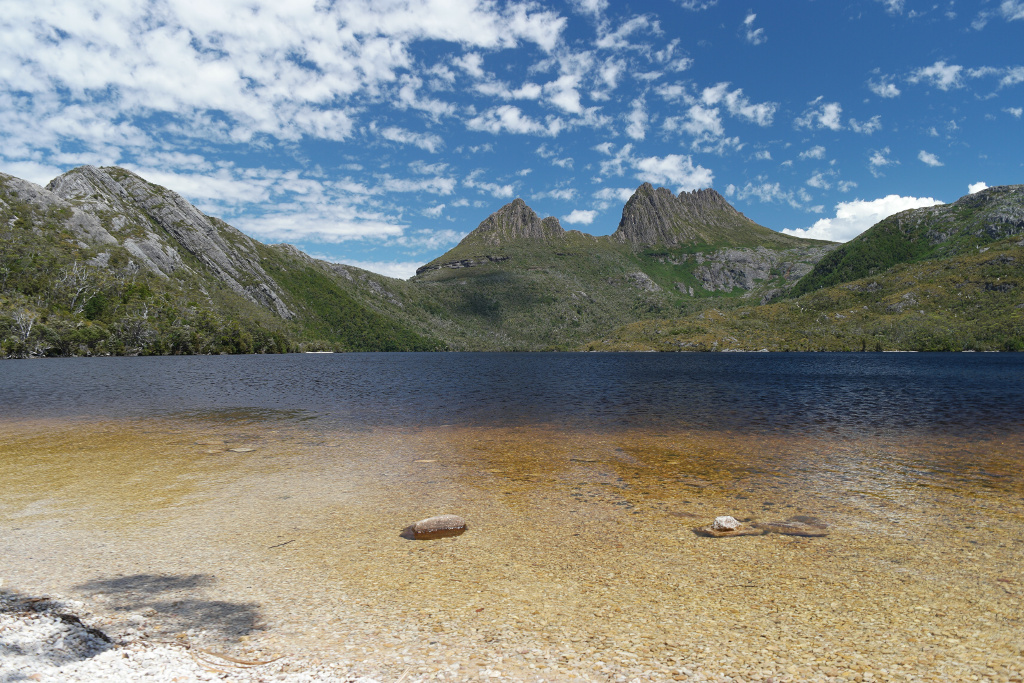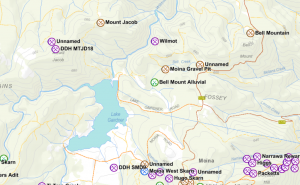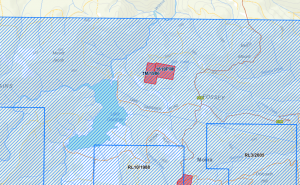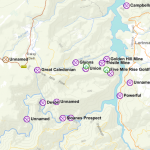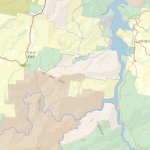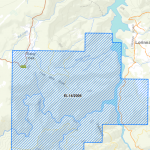Most visitors driving through Moina today are on the way to Cradle Mountain. They would probably be surprised to know that the area, especially Bell Mount, was a bustling alluvial and hard rock mining field in the late 19th and early 20th centuries.
Discovery
The mineral potential of the Moina area was known since at least 1858, when James ‘Philosopher’ Smith prospected alluvial gold in the Forth River near Lorinna, underneath modern Lake Cethana. Prospecting began in earnest in 1889, with a find of payable alluvial gold at the head of a gully draining into the Dove River, near the now-abandoned Great Caledonian Mine. The Middlesex (Five-Mile Rise) area was prospected and developed first, with the Campbell brothers Alex and Malcolm being among the most successful. Their efforts soon turned to Bell Mount, where a decent number of Tasmania’s largest nuggets (over 15 oz.) have come from. The largest weighed in at 22 or 23 oz.
In fact, the only locality that has produced larger nuggets is the Rocky River, and only Salisbury has also produced equal sized nuggets (22 oz.).
Locality and access
The Bell Mount goldfield is located north and west of the current town of Moina, along the bed of Bell Creek and its tributaries. The easiest access to lower Bell creek is through Lake Gardiner Rd.
All of the area is currently (Sep 2017) covered in tenements. There are two active mining leases (1M/1996 and 1619P/M) on the creek, and a large Exploration Licence covers the surrounds. According to the Mineral Resources Development Act 1995, we need permission from the holders of any tenement before we can prospect there. Be particularly mindful of Mining Lease holders: they pay a lot of money to hold the ground, and leased ground is (for all intents and purposes) pretty much equivalent to private property.
- Bell Mount goldfield mineral occurrences Sep 2017. Courtesy MRTmap.
- Bell Mount goldfield tenements Sep 2017. Courtesy MRTmap.
Modern detecting
Rumour has it that Bell Creek has yielded a good number of sizeable nuggets (over 1 oz.) to metal detectorists in modern times. Areas away from the creek can be difficult or impossible to metal-detect in, because of the thickness of the vegetation.
Phil Kemp has some great information about the area in two posts in his Tasmanian Prospecting forum here and also here.
Middlesex: have we lost access?
The other main goldfield in the area was the Middlesex or Five Mile Rise field, east-southeast of Daisy Dell. There were early alluvial workings in the creeks draining northwards into Sunday Creek and a few short-lived hard-rock mines.
- Mineral occurrences in the Middlesex goldfield. Courtesy MRTmap.
- Land tenure types (Sep 2017) in the Middlesex goldfield. Courtesy LISTmap.
- Exploration Licence covering most of the Middlesex goldfield. Courtesy MRTmap.
Much of the Middlesex goldfield was unfortunately incorporated into the controversial 2013 expansion to the Tasmanian Wilderness World Heritage Area. Despite this, the public land is still (as of September 2017) classed as either Regional Reserve or Future Potential Production Forest. These are both tenure types that allow prospecting. An Exploration Licence (EL14/2006) covers the whole goldfield.
My take on this is that you are still (for now) allowed to prospect in Five Mile Rise / Middlesex, provided you have permission from the EL holder. That said, things are likely to change and this post is no substitute for using LISTmap to check up-to-date tenure. Make sure you’re not about to break the law before you set out.
Useful links about Bell Mount and Middlesex:
- A. Montgomery (1893). Report on the mineral discoveries in the neighbourhood of Bell Mount.
- J. Harcourt Smith (1898). Report on the Bell Mount and Middlesex mineral fields.
- G.A. Waller (1901). Report on the mineral districts of Bell Mount, Dove River, Five Mile Rise, Mount Pelion and Barn Bluff.
- W.H. Twelvetrees (1907). Report on the Bell Mount and Middlesex district. (Inside the 1907 Report to the Secretary for Mines, about halfway down)
- W.H. Twelvetrees (1913). The Middlesex and Mount Claude Mining Field.
- A. McIntosh Reid (1919). The Mining Fields of Moina, Mt Claude, and Lorinna.
- E. Broadhurst (1934). Report on the Stormont, Bell Mount and Black Bluff Districts.
Do you have a picture of Bell Mount or of Bell Creek nuggets? If so, and you’d be happy to let me use it here (with all due credit), please get in touch though my contact page.
If you like the content at Apple Isle Prospector, feel free to get in contact, or leave a comment. If you enjoyed this article, then let others know by sharing it on Facebook or liking our Facebook or Twitter pages:

